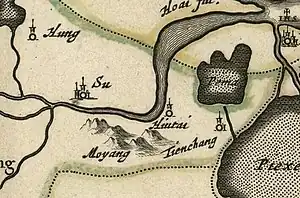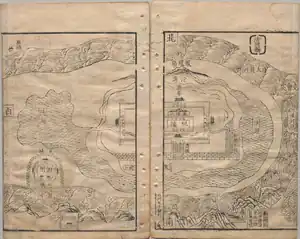Si Prefecture (Huai valley)
Sizhou, Si Prefecture, or Si Subprefecture was a zhou of imperial China variously placed in what is now Xuyi County, Jiangsu, or nearby Si County, Anhui, both in China. Named for the Si River, it existed intermittently from 580 to 1912, during which time the relative position of a zhou within Chinese administrations varied. The same name Sizhou was used for the town used as the seat of the prefectural or subprefectural government, which also varied, and is preserved in modern Anhui's Si County and Sicheng.
| Si Prefecture | |||||||||
|---|---|---|---|---|---|---|---|---|---|
 Sizhou ("Su") on the Huai ("Hoai") shown as a subprefecture of Fengyang in Martino Martini's 1655 Novus Atlas Sinensis. It was subsequently elevated by the Qing to the status of an autonomous subprefecture within Jiangnan Province. | |||||||||
| Chinese | 泗州 | ||||||||
| Literal meaning | zhou on the Si | ||||||||
| |||||||||

Geography
Tang
The administrative region of Si Prefecture in the Tang dynasty is in the border area of modern northwestern Jiangsu and northern Anhui. It probably includes parts of modern:
Qing
Under the Qing, Si Subprefecture formed a division of Jiangnan Province. The subprefectural seat at Sizhou was entirely submerged within Hongze Lake in 1680, along with the nearby Ming Zuling tombs. The seat of government was subsequently moved first to Xuyi in what is now Jiangsu's Huai'an Prefecture and Si County in Anhui.
References
- Shi Weile, ed. (2005). Zhongguo Lishi Diming Da Cidian (中国历史地名大词典) [Large Dictionary of Chinese Historical Place Names] (in Chinese). China Social Sciences Press. p. 1667. ISBN 7-5004-4929-1.